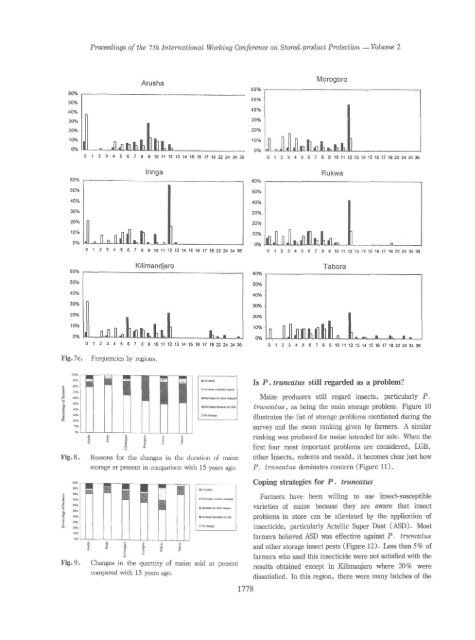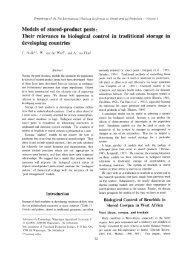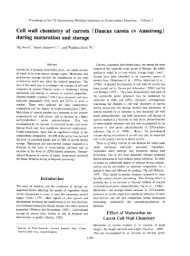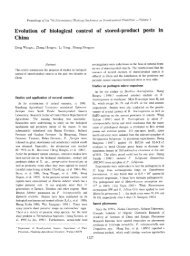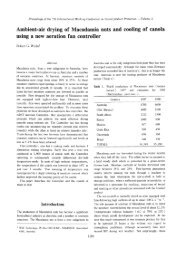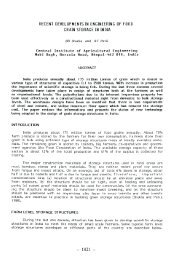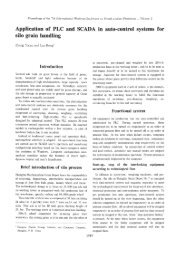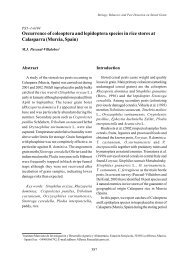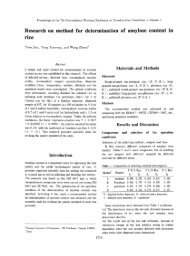Coping strategies employed by farmers against the larger grain ...
Coping strategies employed by farmers against the larger grain ...
Coping strategies employed by farmers against the larger grain ...
You also want an ePaper? Increase the reach of your titles
YUMPU automatically turns print PDFs into web optimized ePapers that Google loves.
60%<br />
50%<br />
Proceedirup: of <strong>the</strong> 7 th Iniematumol Working Conference on Stored-product Protection - Volume 2<br />
Arusha<br />
------------------------<br />
a , :2 3 4 5 6 7 8 9 10 11 12 13 14 15 16 11 1S 22 24 34 36<br />
60%~ r·-··-·--~-··-·-,·,·-<br />
50%<br />
40%<br />
30%<br />
Iringa<br />
20% ]<br />
10%<br />
0% n non<br />
n JlJ]<br />
illl ~~.ou. -----J<br />
o , 2 3 4 5 6 7 B 9 1011 12 13 14 15 16 17 18222434 36<br />
Kilimandjaro<br />
60% r---------...:..------------,<br />
50%<br />
40%<br />
30%<br />
20%<br />
10%<br />
0%<br />
o 1 :2 3 4 5 6 7 S 9 10 11 12 13 14 15 15 17 18 22 24 J.4 J6<br />
Fig.7c. Frequencies <strong>by</strong> regions.<br />
.. i r I<br />
"<br />
i<br />
DNQQ"""ge<br />
Fig. 8. Reasons for <strong>the</strong> changes in <strong>the</strong> duration of maize<br />
storage at present in comparisonwith 15 years ago.<br />
I .Un.l>.t.o --<br />
I t;lD.c",",e,'''''>onun.l>''''<br />
Morogoro<br />
60% -----<br />
I<br />
50% I<br />
40%<br />
30% I<br />
20%<br />
10%<br />
0%<br />
60% I<br />
50%<br />
40%<br />
30%<br />
20%<br />
10%<br />
0%<br />
U~~~<br />
~<br />
o , :2 3 4 567 B 9 1011 1213 14 15 16 17 18222434 36<br />
Rukwa<br />
fuJWJkl~J<br />
o 1 :2 3 4 5 6 7 8 s 10 11 12 13 14 ,5 16 17 18 22 24 ~4 36<br />
Tabora<br />
60% .r--------------------~<br />
50%<br />
40% .<br />
30% -<br />
20'%<br />
o 1 :2 3 4 5 6 7 8 9 10 11 12 13 14 15 16 17 18 22 24 34 36<br />
Is P. truncatus still regarded as a problem?<br />
Maize producers still regard insects, particularly P.<br />
truncaius , as being <strong>the</strong> main storage problem. Figure 10<br />
illustrates <strong>the</strong> list of storage problems mentioned during <strong>the</strong><br />
survey and <strong>the</strong> mean ranking given <strong>by</strong> <strong>farmers</strong>. A similar<br />
ranking was produced for maize intended for sale. When <strong>the</strong><br />
first four most important problems are considered, LGB,<br />
o<strong>the</strong>r Insects, rodents and mould, it becomes clear just how<br />
P_truncatus dominates concern (Figure 11).<br />
<strong>Coping</strong> <strong>strategies</strong> for P. truncatus<br />
ONe""""9"<br />
;; j ~ ~ 1 Farmers have been willing to use insect-susceptible<br />
varieties of maize because <strong>the</strong>y are aware that insect<br />
problems in store can be alleviated <strong>by</strong> <strong>the</strong> application of<br />
insecticide, particularly Actellic Super Dust (ASD). Most<br />
Fig. 9.<br />
e<br />
3<br />
~ , ~ ~<br />
x<br />
Changes in" <strong>the</strong> quantity of maize sold at present<br />
comparedwith 15 years ago.<br />
<strong>farmers</strong> believed ASD was effective <strong>against</strong> P _ truncatw;<br />
and o<strong>the</strong>r storage insect pests (Figure 12) _ Less than 5% of<br />
<strong>farmers</strong> who used this insecticide were not satisfied with <strong>the</strong><br />
results obtained except in Kilimanjaro where 20% were<br />
dissatisfied. In this region, <strong>the</strong>re were many batches of <strong>the</strong><br />
1778<br />
0<br />
I<br />
I


